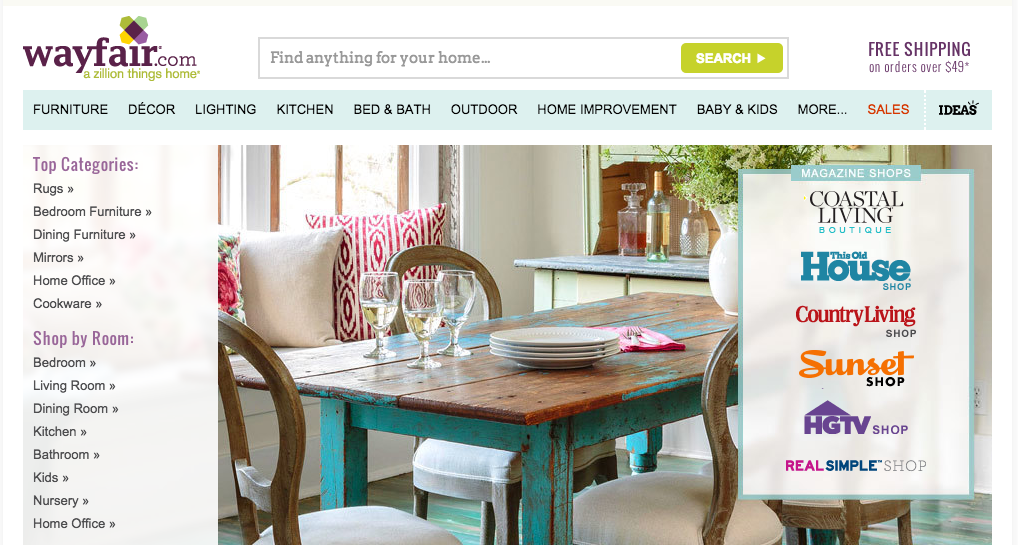In “Drop Shipping for Ecommerce, Part 1: Supply Chain History,” my first article, I addressed the basic supply chain evolution inside of ecommerce. Then, in “Part 2: The Basics,” I defined drop shipping, reviewed contradictory real-world advice about it, estimated how large it might be, and outlined some specific challenges to adopting it. Last month, in “Part 3: Suppliers vs. Retailers,” I addressed how drop shipping alters the traditional relationships between suppliers and retailers.
In this “Part 4,” I’ll address strategies for drop shipping success.
The big news in ecommerce two weeks ago was that Wayfair — the 12-year-old, 2,000 employee, online-only, home-decor retailer — went public with a $2 billion market capitalization. It’s timely for this series on drop shipping, as nearly all of Wayfair’s estimated $1.3 billion 2014 sales will be drop shipped to millions of customers directly from manufacturers. Wayfair works with 7,000 third-party sellers that represent 7 million unique products.

Wayfair, a large home-decor ecommerce firm, relies on drop-shipped products for most of its revenue.
Alex Finkelstein is general partner with Spark Capital, a venture capital firm that invested in Wayfair. He said, “In my mind, that’s the secret of the business — teaching thousands of small, mid, and large manufacturers how to do drop-ship so well. That’s what really enables the engine behind the engine to work.”
How do Wayfair and others do it?
First: You Still Need to Sell
The role of a retailer can provide huge benefits to consumers. However, retailers have to work to justify their existence as middlemen. What value do you really add? Many times, the mental narrative of becoming a retailer goes something like this: “Well I can’t create my own products, so I’ll sell others. Where to sell? Obviously online, to avoid complex, expensive, and outdated physical storefronts. Shoot, what products should I resell? And wait, to resell something, I have to buy them first? Where would I get the money? Where would I put them? I know, I’ll drop ship them. Virtual products from suppliers. Easy. Let’s roll.”
The problem with this narrative is it unfairly shifts the focus to the mindset that the first strategic step is finding the right drop shipping suppliers and their products. Almost all successful retailers, not just in the online world, add value by having some sort of unique selling proposition. Drop shipping somehow gets everyone focused on the product side first, rather than the selling side.
Remember the classic 4 P’s of marketing: product, price, promotion, place. In an Amazon and other marketplace-dominated ecommerce world, it’s especially critical to understand these dynamics. If you are drop shipping products that many others have access to, and you’re promoting those products in a place where everything from the presentation of the product to the product data and descriptions are standardized, the only P you have left is price. That’s a failing race to the bottom.
All products can start to look like commodities. Placing too much stock in a supply side focus — based on drop shipping — seems to keep many retailers from identifying the more important need: in a virtual hyper-connected and hyper-competitive world, you really need to identify your unique selling proposition. Wayfair developed hundreds of unique branded and niche domain names for each product category. RacksAndStands.com was the first site; it sold stands for TVs. It started with a unique way to sell.
There is a large amount of information here on Practical Ecommerce that will help you develop your strategy for unique selling. Start there. Write your unique selling strategy down. It’s what you need to do first. Then come back to the rest of this article because you will then need to develop your unique product assortment and supply proposition, and drop shipping provides many new opportunities in this regard.
Here are three proven drop-shipping strategies.
Strategy: Emphasize Curation
One of the most important roles a retailer provides is curation. Consumers look to retailers to be selective. It’s a huge value to tell the consumer what to buy — by the product you did not select. Just because the product is available, doesn’t mean it makes sense for you to make it part of your selection. Drop shipping removes the traditional friction that drove curation out of necessity — limited dollars for inventory. But that friction isn’t bad. Successful retailers don’t just take a data feed of thousands of products from their suppliers and blast it unchecked to their ecommerce storefront. Furthermore, they generally work with more niche suppliers, such as branded manufacturers.
One of the most important roles a retailer provides is curation. Consumers look to retailers to be selective. It’s a huge value to tell the consumer what to buy — by the product you did not select.
Wholesale distributors do not carry niche products. So if you think you can find several of the big distributors with hundreds of thousands of products and push all of that out to Amazon, you are just wasting your time. As a general rule, a category dominated by distributors is one you are going to have to work 10-times as hard to truly have a unique product assortment. Carefully select your supplier partners in a smart category, and then curate and limit their products as you put together your product selection.
Strategy: Experiment, Then Make Smarter Bets
Many successful retailers use drop shipping as a way to test new products and vendors. How good is it to have a virtual storefront where you can add a virtually-sourced product to your assortment and if the product doesn’t sell, you didn’t lose money from the inventory buy?
But the flip side is that if you knew you could sell a product repeatedly, the economics can be better to actually make those inventory buys. This strategy works especially well on two fronts. First, work with the existing vendors you buy wholesale inventory from. Expand deeper into their product selection with drop shipping.
Second, for new vendors, if you migrate from being a drop-ship vendor to a stocking vendor, many of your trading partners will invest time and resources they might not otherwise be willing to spend initially. Don’t shy away from physical inventory and the more traditional wholesale process. It can be a very big strategic advantage in your relationships with suppliers. Even Wayfair maintains warehouses in Kentucky and Utah so that it can offer fast, 2-day shipping on tens of thousands of items whose past sales justify them bringing into inventory.
Strategy: Consider the Consumer
It is critically important to think about the consumer experience. It starts with the virtual product presented on your ecommerce storefront. Many successful retailers approach the product data piece by being very hands on and using data supplied by the vendor only as a starting point. They make it part of the curation process to write their own product descriptions and even sometimes capture their own images. Not only does it ensure rich and complete data presented to the shopper, it also helps in other ways, such as search engine optimization.
Effective retailers also consider inventory availability. If the manufacturer is creating products continually, or has deep inventory stock, there is far less risk that you end up selling something that can’t be fulfilled. It’s also important to understand a consumer’s need for transparency into the ordering and fulfillment process of drop shipping.
A drop-shipping retailer is not going to box up a product and ship it. Consumers need to know that you have a partner involved in the fulfillment. Years ago that was a negative. But in today’s world, with so much drop shipping and with the existence of major marketplaces, consumers are becoming used to transparency that the company they’re buying from isn’t the company that is holding and fulfilling the product.


